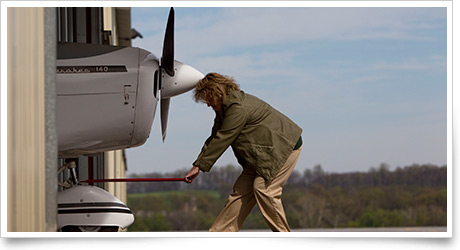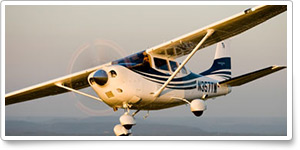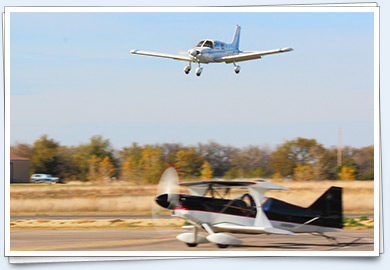Dec. 21, 2012, issue of 'AOPA ePilot: Flight Training Edition' weekly newsletter
| ||||||
| Doing it yourself |
| |||||
Training TipsDoing it yourself
Not quite the picture that usually greets you at the airport?
Many student pilots face more of a do-it-yourself proposition when it comes to preparing the trainer for flight. But that's not all bad. What may be lacking in service and amenities may give back as invaluable experience for possible future aircraft ownership. You will certainly come to appreciate the daily labors of airport line crews, and learn a thing or two about proper aircraft handling.
Winter “ramp ops” will also teach critical lessons about safety. Maneuvering an aircraft out of a parking spot or into a safe position for engine start requires thought and care, even more on an ice-crusted ramp. And any pilot who has fruitlessly fussed with frozen tiedown ropes, or tingled at the touch of a well-chilled towbar, will appreciate hearing the warning call “prop clear” from a nearby aircraft that is about to start.
Don’t struggle with a seriously stuck Skyhawk, or risk injury wrestling it into motion by yourself. Call for assistance—of the motorized variety if necessary. Never ignore placards warning against pushing or stepping on a control surface or other aircraft part.
Supervise motorized towing, making sure that the allowable nose-gear turning angle is not exceeded (in a 1980 Cessna 152 it is 30 degrees either side of center). Design of nosewheel steering mechanisms is what determines the limits; your trainer’s may differ.
Fueling the aircraft yourself? Attaching the grounding cable is an essential safety measure even if the line must be fished out of ice or snow. “It’s important to attach the cable to an unpainted surface to ensure good conductivity. Painted tiedown rings don’t count,” wrote Mark Twombly in the March 2009 Flight Training magazine’s “What It Looks Like” column.
Dress for success in the art of winter ground handling. If you have overlooked some important item, it’s not too late to ask Santa for that needed pair of warm gloves. Flight Training News‘Fiscal cliff’ negotiations could bring aviation impactsWith the leaders of both political parties locked in high-stakes brinkmanship over taxes and spending, there is concern that the so-called “fiscal cliff,” and the deep spending cuts and tax increases that would follow, could do significant damage to aviation. The FAA stands to lose $1 billion of its $15.8 billion budget if automatic spending cuts are allowed to proceed, and impacts would be felt by general aviation, aerospace manufacturers, and airline interests alike. Read more >> Database helps experimental-aircraft pilots find instructorsThe Experimental Aircraft Association wants to help pilots of experimental amateur-built aircraft contact flight instructors who can provide them with additional safety training. EAA has published an online list of instructors authorized by the FAA to offer instruction in their own experimental aircraft for hire “for purposes of type specific training.” Read more >> ‘Flight Training’ magazine chat’s featured appsThis week, AOPA e-Newsletter and Social Media Editor Benét Wilson used apps discussed in Flight Training magazine’s monthly chat—FltPln, MyWingMan, AirWX, Radarscope, and FlyQ EFB—as the basis for her review. Read more >> North Carolina community college unveils aviation schoolKinston, N.C.-based Lenoir Community College has unveiled its Aviation Management and Career Pilot Technology Program, reports General Aviation News . The college is touting the two-year program as an affordable option for aviation education, offering a two-year degree in aviation management and career pilot technology, as well as two diploma and four certificate programs. Lost? Stop, look, listen … and askThe more you fly, the more airports you will visit. You’ll quickly learn that every airport has its own nuances with regard to taxiway and runway layouts, and it can become confusing quickly if you’ve never flown into that airport before. While airport diagrams are helpful, the pressure to keep moving quickly or to look like a “pro” can get you lost in a hurry. The solution? Ask for directions. In this segment of the Air Safety Institute’s Ask ATC, listen to a controller’s perspective on asking for progressive taxi instructions. Checkride checklistYou’ve honed your skills and polished the flight maneuvers—and now it’s time to get ready for the checkride. But how much do you know about what to expect during the practical test? Are you ready? Take the Air Safety Institute’s 10-question Private Pilot Checkride safety quiz to test your knowledge and prepare for the best ride of your life. Take the quiz >> A friendly voice in the airA common misperception in aviation is that if you make a radio call for help to an air traffic controller, you will have to do a bunch of paperwork. The truth is that the controllers would rather you contact them than the alternative. Learn more by reading the Air Safety Institute’s Say Intentions: When you need ATC’s help Safety Advisor. Training ResourcesAs a student pilot, you can never buy enough equipment and tools. AOPA e-Newsletter and Social Media Editor Benét J. Wilson went to AircraftSpruce.com and chose 10 items she’d love to see under her Christmas tree. Read more >>
Did you know that student pilots who join AOPA are three times more likely to complete their flight training? Membership includes unlimited access to aviation information by phone (800/USA-AOPA, weekdays from 8:30 a.m. to 8 p.m. Eastern time) or from Flight Training Online or AOPA Online. If you’re not already a member, join today and get the pilot’s edge. Login information is available online. New LSA lands in the USWe received 300 nominations, but only one airport can be deemed the most challenging. How is the Cessna Skycatcher light sport aircraft working out as a trainer? What does the FCC have to say to the FAA about iPads in airplanes? Finally, we fly the newest LSA to land on our shores. Watch all this and more in a recent episode of AOPA Live This Week. Career PilotIs this the formula for flight training success?When Jerry Gregoire and Redbird Flight Simulations first unveiled the FMX full-motion simulator to a skeptical flight training community five years ago, it was unlike anything that had been tried previously. This presented a problem for the company as it sought to create a market for a product that had already been designed, built, and offered for sale. Read more >> FAA may reduce certification hours for military pilotsThe FAA is mulling a change that would allow military pilots to make the transition to becoming an airline pilot by lowering flight hours for a “restricted privileges” airline transport pilot certificate from 1,500 to 750, reports Air Force Times . The article quotes an official from the Air Force Association, who says military pilots might consider an airline career if the change is made. Emirates to open training academy in 2014Dubai-based airline Emirates said it will open the Emirates Flight Training Academy, based at Dubai World Central Airport, in 2014, reports Gulf Business . The $136 million facility will provide flight training for up to 400 students, offering ground school, ab initio flight training, and ground-based simulators.
For more aviation career news, see the Flight Training website. Plane SpotterFreight to behold: Cessna Stationair Training ProductsA VFR 12-month gift subscription to AOPA’s new FlyQ EFB makes a great stocking stuffer for the student pilot on your list. The AOPA member-only price is $69.99 for 12 months when purchased through AOPA. It includes seamless, georeferenced sectionals; more than 700 georeferenced FAA airport diagrams; smart auto-routing based on predicted winds aloft; 3-D synthetic vision; 3-D terrain; highway in the sky (HITS); and electronic flight instrument system (EFIS) display. It also features split screen view, track-up or north-up modes, the AOPA Airports directory information, covering more than 3,100 airport diagrams and AOPA member comments.
ASA’s Cockpit Procedures handbook is another great gift for the student pilot in your life. The handbook offers readers a solid understanding of the underlying principles for, and detailed descriptions of, the checklists and routines used in many flight schools. Users will find it contains a practical definition of airmanship, and covers good habits to develop, effective workload management, and even what you should have in your flight bag.
Note: Products listed have not been evaluated by ePilot editors unless otherwise noted. AOPA assumes no responsibility for products or services listed or for claims or actions by manufacturers or vendors. Member BenefitsNew Year’s fly well resolutionsMost resolutions fade by Jan. 2, but getting healthy keeps you flying longer, so give it a shot. Let’s look at a few corollaries to benefit your health both inside and outside the cockpit. Read more >> BlogsGot a checkride this weekend?Whenever we ask our Facebook friends what their flying plans are for the weekend, invariably they report they’ve got a checkride scheduled, writes Flight Training Technical Editor Jill Tallman. It makes sense; we are, after all, a community for student pilots. So here are some tips for doing your best and nailing that ride. Read more >> Flying maneuvers with a videoAll pilots and prospective pilots remember the excitement of the first time they got to take the control of an airplane in flight. Neil Hershman recalls his “discovery flight” when, passing through 1,000 feet, the instructor sitting next to him said, “why don’t you hold the stick and make a turn to the right.” Read more >> Moral courage awardMoral courage can be thought of as the willingness to make sound safety decisions even when they are difficult or unpopular, writes blogger Tim McAdams. Many times the pilot that exercises the courage to turn down a flight is making a tough decision, and in many cases the pilot’s actions go unnoticed. Although it is impossible to know about the accident that didn’t happen, it is a reasonable assumption that a certain percentage of no-go decisions have prevented accidents and possibly saved lives. Read more >> Community
AVIATION EVENTS & WEATHER
| ||||||||||||||||||||||||||||||||||||




 It's a calm sunny day, perfect for the important solo cross-country that you planned overnight. Your trainer has been towed from its sheltered spot in the warm hangar, and now sits on the ramp, wheels chocked, fuel tanks full. Soon you will preflight and launch on this milestone training flight.
It's a calm sunny day, perfect for the important solo cross-country that you planned overnight. Your trainer has been towed from its sheltered spot in the warm hangar, and now sits on the ramp, wheels chocked, fuel tanks full. Soon you will preflight and launch on this milestone training flight.



